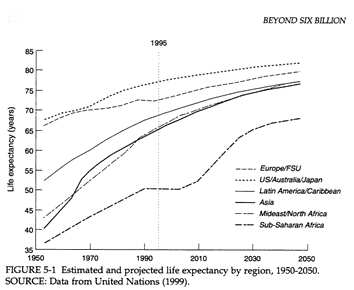 percent. Since 1980, infant mortality rates had declined by 40
percent. Indeed, according to most indicators, our culture's war against
death was going well.
percent. Since 1980, infant mortality rates had declined by 40
percent. Indeed, according to most indicators, our culture's war against
death was going well.The last published vital statistics of the century were certainly
impressive. According to a
report from the Johns Hopkins School of Hygiene and Public Health in Baltimore,
the 1998 American death rate was 470.8 per 100,000 population, the lowest
ever recorded. Average life expectancy reached a high of 76.7. Deaths from
AIDS were down 21 percent, homicides down 14 percent, and suicides down 6
 percent. Since 1980, infant mortality rates had declined by 40
percent. Indeed, according to most indicators, our culture's war against
death was going well.
percent. Since 1980, infant mortality rates had declined by 40
percent. Indeed, according to most indicators, our culture's war against
death was going well.
According to the World Health Organization's 1997-1999 World Health Statistics Annual (see also the World Health Report 1998), life expectancy averages 64 years in the developing nations and is approaching 80 years in some industrial nations. As can be seen from the information provided at this site, the causes and life-cycle timing of death are profoundly shaped by level of socio-economic development. Also shaped is the gender distribution of death.
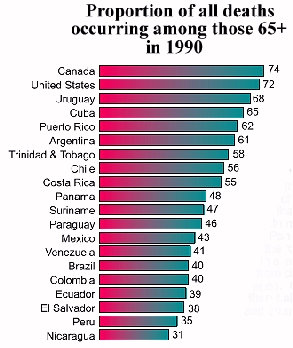
As human life expectancies approach their biological
limits, death comes increasingly to those who have lived full lives and
who perhaps are more ready to die (perhaps even preferring death to continued
existence) than earlier generations (See Brad Edmondson's "The Facts of Death," American Demographics
[April 1997], "A Profile of Death
and Dying in America" from Approaching Death: Committee on Care at End of
Life, and "Top
10 Causes of Death Among Adults Over Age 65" from About.com.
Click
here for table showing life-expectancy changes over the past century.).
In fact, in the U.S. in 1996, one-quarter of the 2.314 million deaths that year
were individuals 85 and older (up from 20% in 1985).
Take a moment to digest and "play with" some of these
statistics. Things get interesting when you see how these indicators vary
when broken down by various sociological categories. For instance, when
examining the longitudinal life expectancy data for blacks and whites observe
how projections indicate that black females in the year 2050 will have reached
the life expectancy of white females 50 years earlier, in 1996, and that in 2050
black males will only have reached the life expectancy of their white
counterparts 70 years earlier, in 1980. And what lessons can be learned
from the various life-expectancy ratios in the table below?
| Life exp in: | 1900 | 1996 | FEM/MALE | BL/WH |
| BL MALE | 32.5 | 66.1 | 1900= 1.03;
1996=1.12 |
MALE 1900=.70
MALE 1996=.89 |
| BL FEMALE | 33.5 | 74.2 | ||
| WH MALE | 46.6 | 73.9 | 1900=1.05;
1996=1.08 |
FEM 1900=.69
FEM 1996=.93 |
| WH FEMALE | 48.7 | 79.7 |
Partially determining the life-expectancy figures is infant mortality. A 2006 Save the Children report revealed that among 33 industrialized nations the United States ranks next to last in its newborn mortality rate, tied with Hungary, Malta, Poland and Slovakia with a death rate of nearly 5 per 1,000. Japan had the lowest newborn death rate with 1.8 per 1,000; Liberia the highest with 65. The rate among African Americans was 9, closer to the newborn mortality rates of developing countries.
Those who do die "prematurely," before old age, increasingly die of man-made (and, hence, theoretically avoidable) reasons, such as by accident, homicide, suicide, or lethal lifestyles. In Australia in 1998, for instance, heroin overdoses accounted for nearly one in 10 deaths among those aged 15 to 44. Click here to see the leading causes of death in U.S. broken down by sex, race, and age (and here to see how these causes have changed over the past century). Accidents and violence now account for two-thirds of all deaths of Americans one to nineteen years-of-age. And those dying in old age increasing die slow motion deaths from chronic ailments such as Alzheimer's Disease (which is the 11th leading cause of older Americans' deaths), often dying socially-- as when institutionalized within a nursing home--before expiring biologically. Check out the Centers for Disease Control's Atlas of U.S. Mortality, featuring maps of the 18 leading causes of death in 1988-92 by race and sex broken down for Health Service Areas, and its Deaths: Preliminary Data for 2002 (which reports how the age-adjusted death rate of African Americans was 58% higher than for whites). The CDC's Web-based Injury Statistics Query and Reporting System allows provides researchers with customized injury-related mortality data and leading causes of death reports.Because of the historically relative scarcity of premature deaths due to "natural causes," there is an interesting cultural impulse to give consolation to those denied a normal lifespan, particularly children who are terminally ill or who have life-threatening ailments. Institutionalizing this impulse are such wish granting charities as the Make-A-Wish Foundation and Dream Factory Inc.
![]() Click here for additional health statistics
resources, such as the American Cancer Society's "Cancer Statistics for
2003", the National Cancer Institute's Atlas
of Cancer Mortality in the United States, 1950-94, and the National Center
for Health Statistics' Deaths: Final Data for 1998.
Click here for additional health statistics
resources, such as the American Cancer Society's "Cancer Statistics for
2003", the National Cancer Institute's Atlas
of Cancer Mortality in the United States, 1950-94, and the National Center
for Health Statistics' Deaths: Final Data for 1998.
Increasing we hear the Greek Tithonius myth applied
to the contemporary aging story. In this immortality parable, a beautiful
young man asked Aurora, the goddess of morning, to make him immortal. She
does. He ages continuously. Finally, pitying his never-ending dissolution,
she makes him into a grasshopper. Instead of making the oldest of the old
into grasshoppers, the medical establishment has produced a population
requiring ever greater services with advanced age--including the million
or more nursing home residents so disabled that twenty-four hour care is
required, and the ten thousand individuals existing in irreversible vegetative
states. National estimates reveal approximately one- quarter of the aged
to be in need of some type of long-term care (U.S. Select Committee On
Aging, 1987). This Tithonius myth is poignant in light of media stories
(e.g., Grandy, Denise. 1996. "A worm's life: Right mutation makes
it long but very dull." New York Times [May 21]) of Siegfried
Hekimi and Bernard Lakowski's studies of the "clock genes" of
Caenorhabditis elegans, a small, short-lived worm. The biologists found
in their numbers strains with five times the normal life expectancy. The
characteristics of these slimy Methuselahs? They are so sluggish that males
may not even have the energy to mate, reinforcing the notion that the longest
lives are lived by those who live the least. Indeed, our cultural thanatophobia is now thoroughly
interwoven with our gerontophobia. As mentioned elsewhere, death is the barometer by which we measure
the adequacy of social life, such as when we compare cross-cultural death and life expectancy
rates to gauge social progress, compare national homicide rates to infer the stability of
social structures, or compare death rates of different social
groups to ascertain social inequalities. Some death statistics to
ponder: Here's an exercise to impress your prof. Obtain state life tables, which show life expectancy for
each year of age broken down by race and sex. These can be obtained at the National Center for Health
Statistics. Look for "crossover effects," that is, the
age at which a minority has a greater life expectancy than his or her white
counterpart. Correlate these with state median incomes for whites and
blacks.
When you leave Houston Intercontinental Airport from
the Mickey Leland Terminal, and fly to Dallas' Love Field and then to Oklahoma
City's Will Rogers World Airport, does it both you that all those people
were killed in plane
crashes? In early 2000, "Peanuts" cartoonist Charles Schulz died on the eve of the publication of his last
strip. Muralist Thomas Hart
Benton died in 1975 the day after completing "A Social History of the State
of Missouri" in the state capitol building. James Fenimore Cooper
and Marvin Gaye died one day before their birthdays. William Shakespeare,
supposedly like Plato, died on his birthday. Actor Telly Savalas died one day after
his birthday, and Louis Braille and Louis Armstrong died two days after
theirs. Coincidence or can death be postponed for social occasions? According to the "death
dip" research tradition of David P. Phillips, it can. Broad
summary and numerous resources are in Heather Royer's "Can the Famous Really Postpone Death?".
In early 2000, "Peanuts" cartoonist Charles Schulz died on the eve of the publication of his last
strip. Muralist Thomas Hart
Benton died in 1975 the day after completing "A Social History of the State
of Missouri" in the state capitol building. James Fenimore Cooper
and Marvin Gaye died one day before their birthdays. William Shakespeare,
supposedly like Plato, died on his birthday. Actor Telly Savalas died one day after
his birthday, and Louis Braille and Louis Armstrong died two days after
theirs. Coincidence or can death be postponed for social occasions? According to the "death
dip" research tradition of David P. Phillips, it can. Broad
summary and numerous resources are in Heather Royer's "Can the Famous Really Postpone Death?".
The Inequalities Revealed By Death
ACCIDENTAL DEATHS
--Lynn Ashby
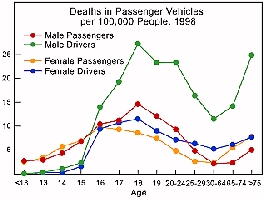 Accidental deaths do not occur randomly but rather affect certain segments of
the population more than others. For example, being left-handed in a
right-handed world shortens life-expectancy according to a study of Southern
Californians conducted by Diane Halpern and Stanley Coren (New England
Journal of Medicine, 1991). They found right-handers living to 75
while left-handers live to only see 66--the latter being five times more likely
to die (7.9% v. 1.5%) of accidents. According to the National
Highway Traffic Safety Administration in 2000, blacks
are less likely than whites to use seatbelts which may be why motor vehicle
crashes are the leading cause of death for African Americans under the age of
15. (Another group keeping tabs on traffic mortalities is the National
Center for Statistics and Analysis, which maintains a Fatality Analysis
Reporting System (FARS).
Accidental deaths do not occur randomly but rather affect certain segments of
the population more than others. For example, being left-handed in a
right-handed world shortens life-expectancy according to a study of Southern
Californians conducted by Diane Halpern and Stanley Coren (New England
Journal of Medicine, 1991). They found right-handers living to 75
while left-handers live to only see 66--the latter being five times more likely
to die (7.9% v. 1.5%) of accidents. According to the National
Highway Traffic Safety Administration in 2000, blacks
are less likely than whites to use seatbelts which may be why motor vehicle
crashes are the leading cause of death for African Americans under the age of
15. (Another group keeping tabs on traffic mortalities is the National
Center for Statistics and Analysis, which maintains a Fatality Analysis
Reporting System (FARS).
According to a report of the National Safety Council released in April of 2000, the number of non-driving related accidental deaths in homes and public places increased 21 percent from 1992 to 1999, reflecting the aging of the nation. See the NSC's "What are the Odds of Dying?" from various types of accidents and injuries. The National Safety estimates that the lifetime odds for someone born in 2001 dying of an injury to be 1 in 23.
The causes of accidental deaths derive not only from man-made sources but include assaults from nature as well. Hundreds of Americans freeze to death each year. The Centers for Disease Control and Prevention estimates about 200 Americans die each year from excessive heat. (During the hot summer of 2003 such deaths became politicized in France when the death toll nearly reached 15,000, prompting harsh criticisms about the failures of nation's health care system by the French Parliament.) And seven times as many males as females are killed each year by lightning. Click here for About.com's Top 15 disaster news sites.
In 1993 there appeared in Times Square an electronic billboard tallying the number of gun-related homicides in the United States, where crude homicide rates are the third highest in the world--4 to 73 times the rate in other industrialized nations, according to researchers at the National Center for Health Statistics. Between 1976 and 1993, more of Americans were murdered in their native land than died on the battlefields of World War II. Homicide is currently the second leading cause of death among Americans 15 to 24 years of age, and the third leading cause among children 5 to 14. According to a study by Child Trends, the infant homicide rate in the U.S. had been increasing over the prior three decades and in 2002 reached the homicide rate of Americans 15 to 19 years of age. Whereas in the 1950s students got under their desks in nuclear war "duck-and-cover" drills nowadays, in the wake of the school shootings around the country, students now use their desks in rehearsing protective strategies against attacks of their classmates.
While homicide rates have generally declined in the West over the past few hundred years, Rosemary Gartner observes (in "The Victims of Homicide: A Temporal and Cross-National Comparison," American Sociological Review, 1990, 55:92-106) short-term upsurges in the early nineteenth and late twentieth centuries. The differences in rates between geographically proximate countries are intriguing: 40 percent higher for Australians than for New Zealanders, 50 percent higher for Italians than for Swiss, three times greater in Norway than in Finland, and four times greater in the U.S. than in Canada.
The question why American homicide rates are so high has,
of course, preoccupied a number of social scientists. Among the reasons typically given
include:
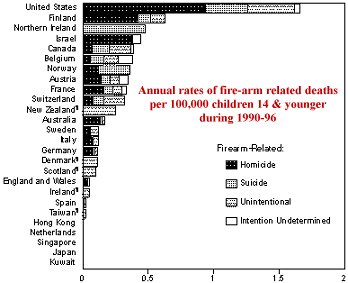
In the 1988, 1989 and 1990 NORC General Social Surveys, Americans were asked if they personally knew someone who had been murdered during the previous twelve months. Ten percent did: 8% of whites and 24% of African Americans (36% of those 18 to 29 years of age). Of those having a connection with a homicide victim, in 13% of the cases it involved a family member and in 40% it was a friend.
What impacts does knowing a homicide victim have? Not surprisingly, it increases individuals' anomie. When considering responses of those who knew and did not know one murdered in the prior year, those in the former category are significantly more likely to agree with the statements "In spite of what some people way, the lot of the average man is getting worse, not better" (by a 68%-59% margin, 81% vs. 56% among those in their thirties) and "It's hardly fair to bring a child into the world with the way things look for the future" (by a margin of 48%-37%, 53%-31% among those in their thirties and 71%-40% among those in their sixties). Generally this anomic effect increases with one's education.
Signs of the times:
Click here to see :

![]()
It's unclear nowadays what really constitutes a "natural" death. Is dying from smoking- related lung cancer classified as "accidental" (should there be one who has not heard of the risks), "suicide" (some say the habit is a slow-motion form), or natural, together with the non-smoking-related lung cancers? And what if these other lung cancers are due to environmental pollution caused by "dirty" industries? Are these deaths "natural" or might they be considered some form of homicide or unintended manslaughter? And how shall we classify the increasing numbers of medically-prolonged or -accelerated deaths, deaths where nature is not allowed to take its course? The American Hospital Association estimated in 1991 that some 70 percent of all deaths are somehow negotiated or timed.
 In addition, let's not forget the role of microbes
in shaping the course of human history. There are various sociological
twists to these biological stories, such as the spread of disease with
increasing international migrations, trade, and travel. Further, there's
the drug-resistant bacteria now emerging from south of the border, where
high-level antibiotic replacements for penicillin are sold over the counter.
Researchers have established
how drug-resistant bacteria, evolving from the heavy use of antibiotic
supplements in animal feeds, are often transmitted from animals to humans.
According to the New England Journal of Medicine, nearly half the
antibiotics sold in the United States are for animals, most of which are
later eaten by people. Finally, might our species be setting itself up
for mass famine given the diminishing genetic diversity of the world's
cash crops?
In addition, let's not forget the role of microbes
in shaping the course of human history. There are various sociological
twists to these biological stories, such as the spread of disease with
increasing international migrations, trade, and travel. Further, there's
the drug-resistant bacteria now emerging from south of the border, where
high-level antibiotic replacements for penicillin are sold over the counter.
Researchers have established
how drug-resistant bacteria, evolving from the heavy use of antibiotic
supplements in animal feeds, are often transmitted from animals to humans.
According to the New England Journal of Medicine, nearly half the
antibiotics sold in the United States are for animals, most of which are
later eaten by people. Finally, might our species be setting itself up
for mass famine given the diminishing genetic diversity of the world's
cash crops?
For most of human history, the Four Horsemen of the Apocalypse--famine, pestilence, war and strife--regularly reduced any population growth (see Plagues Since the Roman Empire, keeping the Malthusian nightmare in check. Perhaps more than anything else, the central accomplishment of modernization has been to keep the first two horsemen at bay, consigning them either to mythology or to the Third World. We now believe that mass death is something we can control, that human ingenuity can keep the natural forces that kill us at bay. But this hubris of modernity has perhaps made postindustrial society more vulnerable to natural calamity when it does occur. The ability of deadly disease to break down the modern social order--to bring about suspicion, fear, and irrational behavior--has received its clearest demonstration in recent memory with the outbreak of the AIDS epidemic. (For rich illustrations of such suspicions and conspiracy theories see the Rethinking AID$ Website.) The American 1980s and 1990s will be remembered for how victims of the acquired immune deficiency syndrome became the modern lepers and how the seams of the social fabric unraveled in ways reminiscent of the Black Plague half a millennia earlier.
In 1995, AIDS became the eighth leading cause of death and the leading cause among all Americans aged 25 to 44, according to data from the Federal Centers for Disease Control and Prevention. AIDS is also the leading cause of death in men and women in 79 of 169 American cities with populations greater than 100,000 population.
More people died of AIDS in 1999 than in any previous year. By mid-2001 things look even more bleak, with a record 3 million people worldwide having died of the disease the previous year, bringing the total to 21.8 million victims and leaving 12 million children orphaned. (For further national-level data, see the UNAIDS/WHO Epidemiological Fact Sheets by Country.) Nearly 36 million people worldwide are infected by the human immunodeficiency virus, a figure that increases by over 15,000 each day. Seventy percent of the planet's victims live in sub-Saharan Africa, where there are 12 women infected for every ten men (with the ratio being 5:1 among those 15 to 19 years of age). The UNAIDS June 2000 Report on the global HIV/AIDS epidemic reports 7 African nations where adult infection rates exceed 20% and projects that fully one-half of all 15-year-olds in the most severely affected countries will die of the epidemic. In these countries life expectancy has decreased by 20-30 years, delaying development by one-half century. (Check the UNAIDS for its socio-economic impact and response to HIV/AIDS publications.) For further socio-cultural effects see the International Labour Organisation's report HIV/AIDS: A threat to decent work, productivity and development(June 2000).
To observe how male and female behavior patterns affect the spread of the AIDS virus, try out the "HIV Simulator" brought to you by the New York Times.

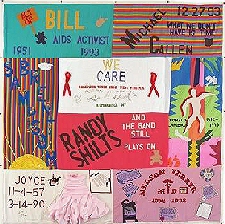
 Estimated risk for an American over a 50-year period.
Estimated risk for an American over a 50-year period.
| Risk of death from botulism | 1 in 2,000,000 |
| Risk of death from fireworks | 1 in 1,000,000 |
| Risk of death from tornados | 1 in 50,000 |
| Risk of death from airplane crash | 1 in 20,000 |
| Risk of death from asteroid impact | 1 in 20,000 |
| Risk of death from electrocution | 1 in 5,000 |
| Risk of death from firearms accident | 1 in 2,000 |
| Risk of death from homicide | 1 in 300 |
| Risk of death from automobile accident | 1 in 100 |
Source: Clark R. Chapman & David Morrison, Cosmic Catastrophes (Plenum Press, 1989)
Contributing to our millennium jitters are renewed fears of death from the natural order, either due to uncontrollable natural phenomena or because of human disruptions of ecosystems. Ecodoom is in, as is catastrophism. According to the National Geographic Millennium site, a rate of global extinction on par with the time of the dinosaurs' demise is already underway. If these scientific themes of time running out were to be made into songs, the Billboard Top 10 tunes would probably include:
![]()